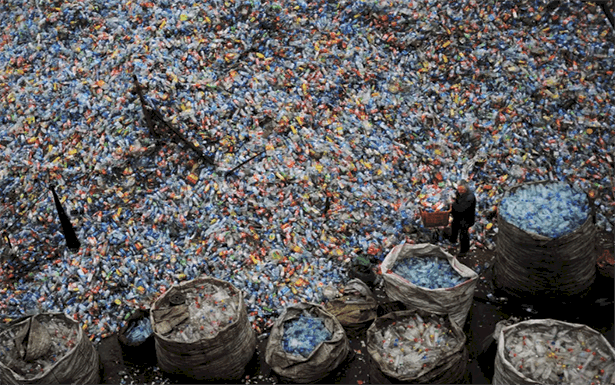Hundreds of American cities are killing or reducing their recycling programs
China stopped importing garbage from other countries. Now, many cities in the United States are facing a recycling crisis.
For many Americans, recycling is practically second nature. It is required by law in cities like New York, San Diego, Pittsburgh and Seattle, where apartment buildings, offices, and restaurants must recycle plastics, cans, cardboard and glass, unless their owners want to face a fine. But even in cities where it isn’t required by law, recycling is mainstream. It has become a virtue of restaurants like Sweetgreen and fashion brands like Gap, H&M and Madewell, which recycle clothes in stores and produce clothing lines made from recycled materials.
However, the problem is that while recycling has become fashionable, it is also becoming more difficult to do.
You may not know where all your recycled products are going, but they are part of a vast ecosystem that spans the entire world and contributes to a $ 200 billion industry. One country that used to be the largest importer of recycled materials, especially to the United States, is China. But last year, it stopped accepting most foreign recyclables as part of an effort to combat the country’s pollution. As a result of this ban, the global recycling system is breaking down, and many cities in the United States are now struggling to figure out what to do with their recycled products.
According to a recent New York Times report, hundreds of local recycling programs in cities and towns across the United States are collapsing. In states like Tennessee, Florida and Pennsylvania, cities are reportedly sending newspapers, cans and bottles to landfills, while others are burning their waste. As the California treasurer said, “We are in a time of crisis in the recycling movement right now.”
The University of Georgia has estimated that China’s ban on recyclables imported from China will leave 111 million metric tons of trash from around the world and there will be no room by 2030. But we don’t even have to look into the next decade to see the consequences, because “it is already happening Tons of recycled paper and plastics are accumulating throughout the country, and this problem has only just begun.
Recycling plays a crucial role in minimizing waste and preserving natural resources. The reuse of materials such as wood, minerals and water reduces the need for growing resources, notes the United States Environmental Protection Agency.
Recycling materials also ensures that waste is not placed in landfills or incinerators, the EPA adds. Burning garbage can be harmful to the environment, according to some experts, because toxic emissions are released into the air in the process. Burning plastic, specifically, is known to release highly toxic compounds, called dioxins. Landfills are also problematic; They can spill dangerous liquids on the ground and possibly contaminate nearby water systems. The decomposition of garbage in a landfill also creates the greenhouse gas methane, which contributes to climate change.
But recycling is also expensive and time consuming. It requires a great deal of water and energy, plus money and effort to build the proper infrastructure. Due to falling oil price costs, virgin plastic is cheaper to manufacture than using recycled materials.
According to the Environmental Protection Agency, approximately 66 million tons of materials are recycled in the US, and nearly a third of these materials are generally exported. Over the past three decades, nearly half of the plastic used worldwide has been shipped to China.
In the early 1990s, China saw a monetary opportunity to use its cheap labor. The country began buying recycled plastic, and then small factories in China used the waste to create low-cost plastic exports, such as shoes, bottles, hoses and gadgets. The United States used to send 4,000 shipping containers of recycled products to China a day. As of 2016, China imported 40 million metric tons of recycled products annually, according to the United Nations.
The country’s massive purchases helped it become a manufacturing hot spot, according to Bloomberg. But the Chinese government has recently been moving the country away from low-value sectors like waste and is focusing more on high-profit industries like technology. In the process of becoming the hub of everyone else’s garbage, the country has also been exposed to mercury, lead, and other hazardous substances that contribute to pollution. In 2017, it announced that it would no longer be the “garbage dump of the world,” as the Times put it.
Since January 2018, China has banned the importation of most plastics and papers. It also adjusted its restrictions on accepting other materials, such as scrap metal. This ban has forced some of the world’s largest companies to rethink plastic. Corporations like Procter & Gamble, Unilever, Nestlé, and PepsiCo have started using reusable packaging. The European Union plans to place a tax on plastic bags and packaging in response to the Chinese ban, and supermarket chains like Trader Joe are trying to minimize the use of plastic.
While the ban is putting pressure on American companies and countries to rethink their environmental footprint, it also caused chaos. A waste management executive warned the New York Times last year that many cities will suffer because garbage in the United States “has nowhere to go,” and cities are beginning to feel the effects.
WasteDive, an industry website that covers waste management, has kept a timeline of how the Chinese recycling ban is impacting the US All US states have been reported to have been seen affected. Some cities are killing curbside recycling collection; Urban recycling centers across the country are also closing.
The US is not the only country struggling to figure out what to do with its recyclables. Australia, for example, has resorted to burying its garbage, while Canada now sends some garbage to landfills or burns it. Ireland is still trying to figure out what to do, as is Germany.
Malaysia, Indonesia, India, and Vietnam still buy recycled plastic in bulk, but no country has yet to take China’s place as a massive buyer of recyclables. Some of these countries do not have the adequate infrastructure to handle the volume of recyclable materials that China processes once. And India is trying to follow in China’s footsteps and ban foreign garbage, as is Malaysia.
Countries are getting tired of buying recycled garbage from the West. Burial and trash burning are Band-Aids in the biggest problem, but the global recycling system must be fixed.

